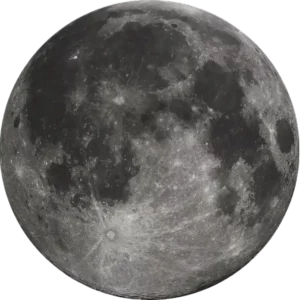How far away is The Moon now?
Last Updated: Today

Where does this live distance data come from?
I source the Moon’s distance from Earth via the Horizon JPL API. It is a free service provided by NASA’s Jet Propulsion Laboratory (JPL) that offers access to ephemeris (positional) data and related information for celestial bodies, such as planets, asteroids, and comets. The system can be accessed through various interfaces, including a web interface, a telnet interface, and an email interface.
This API contains the precise distance between the moon and Earth from each day of the next few hundred years.
So I simply created a system to check for today’s date, then go retrieve the accurate distance value directly from NASA’s database. The up-to-date value is then displayed on this page.
The Moon's orbital parameters
Orbital parameters describe the way objects move around in space, such as planets, moons, and satellites. These parameters include the size, shape, and tilt of the orbit, as well as the object’s position and speed within the orbit.
They help scientists understand and predict the paths of celestial bodies, which is crucial for planning space missions, observing astronomical phenomena, and monitoring satellites.
| Orbital Parameter | Value | Explanation |
|---|---|---|
| Semimajor axis (106 km) | 0.3844 | The longest diameter of an elliptical orbit |
| Perigee (106 km)* | 0.3633 | The point in the orbit of a satellite at which it is closest to its parent body |
| Apogee (106 km)* | 0.4055 | The point in the orbit of a satellite at which it is furthest from its parent body |
| Revolution period (days) | 27.3217 | The time it takes for a satellite to complete one orbit |
| Synodic period (days) | 29.53 | The time it takes for a celestial body to return to the same position relative to the Sun as seen from Earth |
| Mean orbital velocity (km/s) | 1.022 | The average speed at which a satellite orbits around the main body |
| Max. orbital velocity (km/s) | 1.082 | The maximum speed at which a satellite orbits around the main body |
| Min. orbital velocity (km/s) | 0.970 | The minimum speed at which a satellite orbits around the main body |
| Inclination to ecliptic (deg) | 5.145 | The tilt or angle between the orbital plane of the satellite and the plane of the ecliptic (Earth’s orbit around the Sun) |
| Inclination to Earth equator (deg) | 18.28 – 28.58 | The angle between the orbital plane of the satellite and the equatorial plane of the Earth |
| Orbit eccentricity | 0.0549 | A measure of how much the orbit deviates from being circular |
| Sidereal rotation period (hrs) | 655.720 | The time it takes for the celestial body to make one full rotation on its axis with respect to the stars |
| Obliquity to orbit (deg) | 6.68 | The angle between the object’s rotational axis and its orbital axis |
| Recession rate from Earth (cm/yr) | 3.8 | The rate at which the satellite is moving away from the Earth |
Just for fun, how long would it take to reach the Moon via different transportation means
The average distance between Earth and the Moon is 384 400 km (238 855 miles), so based on that distance, I have calculated the time it would take to reach our natural satellite at the speed of different means of transportation.
- On foot (3 mph): approximately 3,472 days
- Bicycle (15 mph): approximately 439 days
- Horse (galloping at 25 mph): approximately 124 days
- Motorbike (average speed of 70 mph): approximately 48 days
- Boat (cruising speed of 20 knots which equals 23 mph): approximately 141 days
- Car (60 mph): approximately 18 days
- High-speed train (322 km/h equals 200 mph): approximately 4 days
- Commercial Airplane (575 mph): approximately 0.6 days (or approximately 14 hours)
- Concorde supersonic jet (1,350 mph): approximately 0.1 days (or approximately 3 hours)
- SpaceX Starship (projected average speed of 16,777 mph): approximately 0.0019 days (or approximately 0.045 hours)
Please note this is only for fun and it does not reflect the reality of space travel. This is a simplification and does not account for acceleration, deceleration, or the gravitational influences of celestial bodies which would play significant roles in actual space travel.
Also, these calculations assume constant speed, which is not how actual space travel works.
Read more here: How long does it take to travel to the Moon?
Bonus Fact: It takes 1.3 seconds for light from the Moon to reach Earth.
How far away are the other planets of the solar system?
I have developed a webpage that monitors the real-time distances between Earth and each planet of the solar system (work in progress):
- Real-time distance between Mercury and Earth
- Real-time distance between Venus and Earth
- Real-time distance between Mars and Earth
- Real-time distance between Jupiter and Earth
- Real-time distance between Saturn and Earth
- Real-time distance between Uranus and Earth
- Real-time distance between Neptune and Earth
- How Far Away Is Earth From The Sun?

I’ve been fascinated by space and astronomy from a very young age. When I’m not watching space-themed documentaries, movies or TV series, I spend most of my free time in my backyard admiring the planets and galaxies with my telescope.
